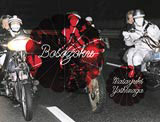Bounding ahead
With the prospect of busy months ahead publishing 13 new books, founder of nascent publisher Trolley, Gigi Giannuzzi books time to meet Hannah Booth

Gigi Giannuzzi has trouble with the word ‘guerrilla publisher’. His PR has described him thus, so I ask him what it means, but he thinks I mean he’s a big hairy publisher who lives in the jungle.
The linguistic misunderstanding cleared up, Giannuzzi, a young, energetic Venetian, explains why the term might apply to his year-old independent publishing company Trolley. ‘I’m interested in exposing those aspects of human life that might not otherwise find an outlet,’ he says.
These include Japanese biker gangs, psychiatric patients in Taiwan and a family of tattoo artists, as featured in Bosozoku, The Chain and The Leu Family: Family’s Iron respectively, subjects which other publishers might avoid.
‘There is little or no medium for photographers, artists and writers to express their work beyond established publishing houses, magazines and, rarely, exhibitions,’ Giannuzzi says.
Trolley may be a young, tiny company – two full-time employees plus a few part-timers, freelances and contractors – but it already has nine books to its name. It also has the weight of art publishing giant Phaidon behind it for its marketing and distribution.
Giannuzzi doesn’t actively seek to make political statements, ‘but I’m happy to support them if I share the statement’, he says. There’s no denying his books have a political quality, but his principle aim is to ‘challenge people’s perceptions of other people’.
Does he employ shock tactics? ‘I have no strategy to shock people, but it can just happen,’ he says. No subject matter is off limits except, perhaps, anything done for purely commercial reasons. This is his bugbear. ‘Creatively, I am editorially not commercially driven. Nothing must interfere with the soul of a project.’
It’s more of a case of what could be ‘on-limits’, says Giannuzzi, who is displaying guerrilla tactics of his own by asking for an ashtray, being told it’s a no smoking area and lighting up anyway. ‘A publisher must have a curiosity for new ideas, and patience to see something through. You have to fight for an artist, and you’ve got to understand the psychology of the [artist] you’re dealing with,’ he says. Trolley’s brochure describes the company as ‘brave and indiscriminately curious’.
A neat example of a long-in-the-making project is Hide That Can, a record of inmates at the Arlington House refuge in London’s Camden by former Dazed & Confused picture editor Deirdre O’Callaghan and arguably Trolley’s best-known book to date (DW 3 October).
O’Callaghan first approached Giannuzzi while he was at independent art publishing house, Westzone, which he established in 1997. He was ‘forced to resign’ four years later, citing the greed of other partners and being ‘backed into a corner’ as reasons.
He jumped on O’Callaghan’s idea, which came in as a package with graphic designer Gerard Saint from design group Big Active already on board, and waited for four years to get the idea off the ground.
Around half the time, a project won’t have a designer attached and Giannuzzi works with graphic specialist Fruit Machine based in London’s Old Street. Fruit Machine comprises Martin Bell and Wai Hung-Young, with whom Giannuzzi shares an office. ‘We have a silent understanding. It’s important to establish that kind of working relationship,’ he says.
‘Some designers are unapproachable, unwilling to discuss things. The “round table” work ethic is important – you’ve got to have mutual respect,’ he adds. He likes to have creative input ‘if he can’.
The design of most of Trolley’s books is deliberately unobtrusive to allow the images to take centre stage. ‘It’s the subtle elements, the little touches, that make a difference,’ Giannuzzi says.
The latest book, published this month called Learn How To Die The Easy Way by Nick Waplington, is highly minimalist. The plain blue cover features a clear plastic sleeve with a red flash incorporating the title, and it is the elaborate content that does all the talking.
It features a series of fictitious websites, first unveiled by Waplington at the 2001 Venice Biennale, designed to show how monstrous the Internet could become. ‘The [Internet] is not bound by social, moral or ethical considerations,’ Waplington explains. ‘We could be in for a very exciting period of development.’
Trolley has 13 titles lined up for publication next year, including volumes on Russian prison camps, English villains and Slovakian gypsies. Which means Giannuzzi’s hectic lifestyle – his mobile rings four times during our interview before he turns it off – will get even busier.
He divides his time between his home in Venice, where he has a large studio, and London, where he has a small one. It’s rather a nomadic life, but one he enjoys. ‘Thank God for Ryanair,’ he says.
Giannuzzi is anxious to keep Trolley small, despite having lots of books he wants to publish. He says because of its size, he inevitably finds himself limited to a certain number of titles, but this ensures he has to be 100 per cent convinced of every book he publishes. ‘Things are ideal at the moment,’ he says.
Gigi Giannuzzi’s CV
1963 Born in Rome
1990 Joins Italian publisher Rizzoli. Responsible for foreign rights in central and South America
1994 Joins Allemandi, a specialist art publisher in Turin, Italy
1997 Establishes Westzone, an independent art publishing company
2001 Sets up Trolley
-
Post a comment




